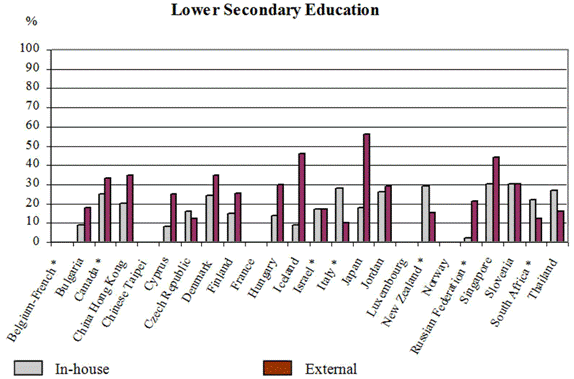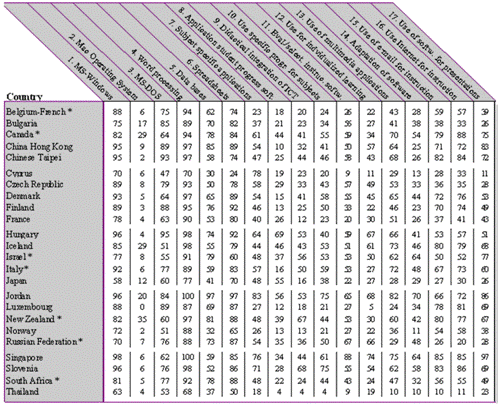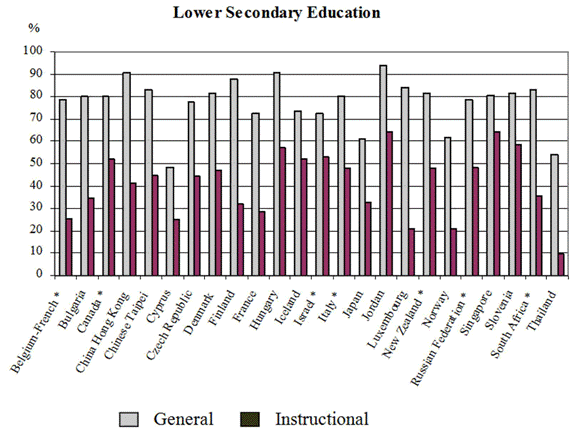| November 2007 Index | Home Page |
Editor’s Note: Training faculty and staff is integral to adoption of new information and communication technologies (ICT). This study, conducted in Jordan, is research verification of the extent to which Information and Communication Technologies function within Jordanian Public Secondary Schools. It also compares the results with surrounding countries. The findings are uncomfortable because the percentage of integration of ICT within many secondary school systems is low and teacher training in ICT is lacking.
Information and Communication Technologies:
ICT Staff Development in
Jordanian Public Secondary Schools
Khalid Ajlouni
Jordan
Abstract
The objectives of this study can be summarized as follows: produce statistical indicators of the extent to which Information and Communication Technologies (ICTs) are integrated in the educational processes; show developments over time and investigate to what extent these are comparable with other countries in the region and beyond; analyze factors that can inhibit or promote the nature and speed of educational changes; and study and document examples of educational innovations that are supported by ICTs. The ultimate objective is to identify best practices that can be implemented and disseminated into the system at large. The results of this study show that a very crucial condition for changing pedagogical practices and integrating ICTs is that teachers and support staff need to be adequately trained in order to feel comfortable with ICT applications in their daily instructional activities. A substantial number of school principals think that many teachers do not yet possess the required ICT knowledge and skills, despite the fact that almost all teachers have received some form of training. Along with this, technical resource personnel at schools indicated that, although their technical knowledge was quite acceptable, only half of them thought that they were well-prepared regarding didactical and organizational integration of computers. This state-of-affairs is not a phenomenon that is exclusively witnessed in Jordan. To the contrary, it was observed in many of the other countries included in this study.
Keywords: Information and Communication Technologies, ICT, Staff Development, Schools
Background
Since 2002, the Jordanian Government has been striving to introduce major reforms in the overall educational system in the country. The following four policy orientations were formulated:
Re-structuring the educational system to ensure lifelong learning
Ensuring responsiveness and relevance of the educational system to the ever-changing needs and demands of economy
Accessing and utilizing information and communication technologies to support effective learning and system management
Ensuring quality learning experiences and environments
In the Spring of 2004, the first round of this study initiated a survey amongst a sample of Jordan’s Ministry of Education (MoE) schools. One of the main topics that this survey addressed was in relation to staff development especially in relation to ICT skills knowledge and use by teachers and school personnel (ICT-monitor).
The design and instrumentation of this study in Jordan was based on the methodology that was developed in the Second Information Technology in Education Study (SITES) and run between 1998 and 2003 by the International Association for the Evaluation of Educational Achievement (IEA). The 2004 study provides baseline data for evaluation of changes in the field of ICT that may occur in the forthcoming years. Moreover, by comparing the current situation in
Many studies (Harris, 2002; Lucock & Underwood, 2001) have explored the contribution that ICT can make to the processes of teaching and learning. Some of these studies have focused on students’ outcomes, while others have focused on pedagogy. SITES, organized by IEA, was designed to make a further contribution to the growing body of evidence concerning the effective use of ICT within an educational context (Harris, 2002). In their study which investigated the role of technology coordinators in three
Along the same line, Becker (1994) found that exemplary computer-using teachers in US schools were more likely to be found in schools with adequate professional development and computer coordination. A study exploring an ICT initiative in British schools (Somekh, Barnes, Trigg, Sutherland, Passey, Holt, Harrison, Fisher, Joyes, and Scott, 2001) found that the ICT coordinators in many of these schools were responsible for a number of areas, such as: professional development, students’ skill levels, development of infrastructure, and use of ICT to support teaching and learning. They noted that coordinating ICT to support teaching and learning was an area that received little attention when needed to provide technical support.
A great deal of theoretical and empirical work has been done for several decades regarding the impact of ICT on educational processes. The incorporation of ICT into the school has affected its functioning at multiple levels: viz., new configurations of learning spaces and timetable have been created; innovative teaching methods have been devised; autonomous and active learning processes using the technology have been adopted; teachers’ traditional roles have been expanded and included personal and group tutoring and guidance functions, and new ICT-based curricular solutions have been generated (Mioduser, Nashmicas, Tobin, and Frankish, 2002).
Policy Issues, Concepts, Indicators, and Research Questions
The conceptual framework of SITES-M1 (Module 1) was designed as a collaborative activity by researchers from over 25 countries (Pelgrum & Anderson, 2002). It took into account policy documents and research literature on ICT with a view to developing a conceptual framework in which four areas were distinguished (curriculum, infrastructure, staff development and management/organization). This framework was used as a basis for mapping indicators, generating research questions and constructing instruments. It is important for any country that considers repeating SITES-M1 to verify that all concepts, indicators and research questions from SITES-M1 are still relevant, given the actual status of educational policies. The following list of indicators related to the concept “Staff Development” can be obtained From Pelgrum & Anderson (2002):
Problems with regard to staff qualifications
Policies with regard to staff development and its realization
Methods of transferring ICT-related knowledge
Availability of ICT-training courses
Respondents’ self-ratings
Research Questions
For the purpose of this study, the following questions were highlighted:
To what extent are teachers adequately trained in ICT?
Have schools adopted specific policies regarding staff development on ICT?
To what extent are staff development facilities available in schools?
How is ICT- related knowledge transferred at schools?
Which ICT-related courses are available for teachers?
To what extent are technical resource personnel at schools adequately prepared to support maintenance and pedagogical ICT related activities?
Population Definitions and Sampling Design
The population of this study comprises all MoE-schools in which students from grade 7 or higher are enrolled, and which house one or more computer lab (with at least 15 operational computers). This resulted in a list of 1240 schools housing 351,279 students. The total number of schools that enrol students in grade 7 in Jordan is 1,862. This means that approximately 67% of schools in Jordan had access to computers in 2004. This estimate was derived from the Third International Mathematics and Science Study TIMSS-2003 data.
Instruments
The instrumentation of SITES-M1 consisted of a questionnaire addressed to school principals (further referred to as “Principal Questionnaire”) and another questionnaire designed for a person in the school who was knowledgeable about the ICT infrastructure and its use. This last questionnaire is referred to as “Technical Questionnaire”. The SITES-M1 questionnaires were translated into Arabic by the researcher. However, several ICT specialists and students who hold a degree in English Language double-checked the translation. The translated questionnaires were piloted by a group of university students who also had jobs as school principals or as teachers.
Data Collection
Data collection in
In order to monitor developments regarding the ICT-staff development, the current issues were assessed on the basis of the research questions:
Are Teachers Adequately Trained?
A considerable number of school principals (61%) indicated that a lack of teachers’ knowledge or skills seemed to be a major obstacle in realizing the school’s ICT related objectives. However, a small group of school principals (22%) reported it was a major obstacle that teachers felt uncomfortable because some students were more competent with ICT than their teachers.
Policies With Regard to Staff Development and its Realization
Staff development was perceived as an expensive activity, so it was reasonable to expect that schools would set priorities with regard to training their staff members. In order to make sure that adequate answers are provided for the second Research Question: ‘Have schools adopted specific policies regarding staff development on ICT?’, school principals were asked, beforehand, if it was the policy of their schools to train all staff members or only some of them, and to what extent their schools had realized this policy. Table 1 shows the percentage of schools that had adopted goals regarding training of their teachers and percentages of schools that had realized these goals.
Table 1
% Schools that Adopted Goals and % Schools that Implemented Goals
regarding Training of Teachers

The overall observation from Table (1)1 is that training all teachers to use ICT was a policy goal of the majority of schools in most countries. However, in
Methods of Transferring ICT-related Knowledge
It is known from innovation theories that continuous staff development is an important precondition for sustainable progress and for continuous implementation of change. Therefore, it seemed relevant to investigate to what extent schools had set up mechanisms for facilitating the transfer of ICT-related knowledge amongst teachers in their schools in order to address the question in relation to "How is ICT related knowledge transferred in the school?" Transfer may, for example, occur via working groups, the computer coordinator, newsletters, a cascade approach (trained teachers who further disseminate information within the school) and courses within the school. Table (2) contains the percentages of school principals who indicated that each of these arrangements was actually practised and implemented by their schools.
Table 2
% Schools in Lower Secondary Education with arrangements for
Transfer of ICT Knowledge among Teachers

From the above table, it appears that, overall, the most prevalent arrangements involved informal contacts, computer coordinators, courses run by external agencies, and in-school courses. Moreover, the respondents in
Availability of ICT training courses
The availability of training courses is a crucial condition for raising the ICT qualifications of staff. Therefore, a question about this topic was included in the questionnaires in order to address the fourth Research Question about ‘Which ICT-related courses are available for teachers?’.
The percentages of respondents who checked the in-house availability of each possible course are shown in Table (3).
Table 3
% Students whose Schools (technical respondents) indicated in-house
ICT Courses were available for lower secondary-education Teachers

Note: * Counties did not ratify all sampling criteria.
Table (4) contains the percentages for externally available courses.
Table 4
% Students whose schools (technical respondents) indicated external
ICT-Courses were available for lower secondary-education teachers.

Not surprisingly, with regard to the in-house training facilities, the largest percentages were observed for courses relating to basic computer-literacy, basic computer-handling skills as well as the use of basic applications (word-processing, spreadsheets, and databases). It should be noted, however, that in some countries like
General introductory course (how to use a computer, principles of software and hardware, functions of mouse, and printer) (56%).
Introductory course for applications/standard tools (basic word-processing, spreadsheet, databases, etc.) (49%).
Introductory course for Internet use (retrieving information, sending/receiving e-mails, etc.) (41%).
In relation to = external courses, it seems reasonable to expect that training facilities would be available for most of the above mentioned topics. However, as the data in Table (3) reveals, this was, according to the perceptions of the technical respondents, clearly not the case. Another finding of relevance was a relatively small group of the questionnaire respondents indicated that external courses were available and dealt with the didactical / pedagogical principles of computer use and with subject-specific training. The availability of such courses may be hypothesized as an important factor affecting the use of ICT in daily classroom practices. In
Introductory course for applications/standard tools (basic word-processing, spreadsheet, databases, etc.) (52%).
Introductory course for Internet use (retrieving information, sending/receiving e-mails, etc.) (46%).
General introductory course (how to use a computer, principles of software and hardware, functions of mouse, and printer) (45%).
A more condensed impression of the extent of availability of in-house and external courses can be gained from Figure (1). In-house availability in this figure reflects the average percentage of courses that were checked. External availability was calculated in the same way. In general, and again, not surprisingly, more external than in-house courses were accessible for teachers.

Figure 1. Average percentages across schools of available
in-house and external courses.
A relatively high availability of external courses existed, for instance, in China Hong Kong, Cyprus, Hungary, Iceland, Japan, Russian Federation, and Singapore; while it was relatively low in, for example, Italy, New Zealand, South Africa, and Thailand. For Jordan, it appears that the availability of external courses was a little bit higher than the availability of in-house courses.
On the whole, however, the availability of courses (at least in the perception of school principals) tends to be low. This is consistent with the finding that a substantial number of school principals reported that lack of training facilities was a major obstacle in realizing the schools’ ICT-related objectives; while also a meaningful number of respondents found the quality of available teacher training courses as insufficient (53%). This was often viewed as a major obstacle for most of the other countries. In Jordan, however, it was mentioned most frequently.
Knowledge and Skills of Technology Coordinators in the Schools
If one assumes that the person who answered the technical questionnaire is also the one who plays an important role in transferring knowledge within the school, it would then be important to know to what extent these persons were adequately prepared for their work in supporting ICT activities within the school. In order to acquire and estimate such an indicator, the questionnaire respondents were asked to rate how well-prepared they thought they were in relation to each of the following areas:
General
1. MS-Windows
2. MacOs
3. MS-DOS
4. Word processing
5. Databases
6. Spreadsheets
Instructional Processes
7. Subject specific applications
8. Application of student progress tracking software
9. Didactical and organizational integration of computers in subjects
10. The use of specific programs for subjects
11. Evaluation and selection of instructional software
12. Use of computers for individualized learning programs
13. The use of multimedia application
14. Adaptation of software to fit school purposes
E-mail, Internet, WWW
15. The use of e-mail for educational purposes
16. The use of the Internet/WWW for educational purposes
Presentation
17. The use of software for making presentations
If the area was not relevant, respondents would be allowed to check a box entitled: 'Not Applicable.' Table (5) highlights the percentages of respondents who answered each item affirmatively. Some general observations can be made on the basis of data collected in this table. Overall, it seems that the highest self-assessment in relation to adequacy of preparation occurred for word-processing. It is not surprising to find that self-assessments were low for the Mac operating system as the majority of schools do not yet use these operating systems. In some countries (for example, Canada, Singapore, and Slovenia), 85% or more of the respondents indicated that they felt adequately prepared to use the Internet for instructional purposes. However, this was barely the case in other countries like, Bulgaria, Cyprus, Czech Republic, Japan, Russian Federation, and Thailand.
Table 5
% Students whose Schools (technical respondents) indicated they are adequately prepared to support ICT-activities for lower-secondary Education.

Notes: */ country did not satisfy all sampling criteria.
On the basis of answers received from Jordanian respondents, the rank order of items addressing adequacy of preparation was as follows:
Table 3
Adequacy of Preparation
Rank | Item | Percentage |
1 | Word processing | 100% |
2 | Databases | 97% |
3 | Spreadsheets | 97% |
4 | MS-Windows | 96% |
5 | The use of software for making presentations | 86% |
6 | MS-DOS | 84% |
7 | Subject specific applications | 83% |
8 | The use of multimedia application | 82% |
9 | The use of specific programs for subjects | 75% |
10 | The use of the Internet/ | 72% |
11 | Adaptation of software to fit school purposes | 70% |
12 | Use of computers for individualized learning programs | 68% |
13 | The use of e-mail for | 66% |
14 | Evaluation and selection of instructional software | 65% |
15 | Application of student progress tracking software | 56% |
16 | Didactical and organizational integration of computers in subjects | 53% |
17 | MacOs | 20% |
From these items, two scales were created, one reflecting the extent to which general ICT skillls were mastered, and the other reflecting the instructionally related topics. Figure 2 includes the average percentages for each of these scales in each country.

Figure 2. Average values of self-ratings from technical respondents regarding the adequacy of preparation for supporting general ICT-related and pedagogical ICT-related activities in lower-secondary edu cation.
A first observation from this figure is that the self-ratings for the general (or alternatively more technical) ICT-related activities were much higher than those for the instructionally related activities. With regard to the latter activities, the ratings were relatively high in Jordan, Hungary and Singapore. However, the instructionally related ratings were comparatively low in Belgium-French, Cyprus, France, Luxembourg, Norway, and Thailand.
Summary of Findings
One basic and very crucial condition for changing pedagogical practices and integrating ICTs in education is that teachers and support personnel need to be adequately trained in order to feel comfortable with ICT applications in their daily instructional activities. A substantial number of school principals assert that many of their teachers, as yet, do not have the required ICT knowledge and skills, despite the fact that almost all of them have received some form of training in this regard. At the same time, technical resource personnel in the schools indicated that although their technical knowledge was quite acceptable, only half of them felt that they were well-prepared regarding the didactical and organizational integration of computers. This state-of-affairs is by no means a phenomenon that is exclusively witnessed in Jordan. To the contrary, it was observed in a great number of other countries included in this study. Almost all schools intended to train all teachers to use ICTs and a few teachers to become ICT-specialists. These goals are, according to the perceptions of school principals, realized in 40% of the schools. This is a fairly high percentage when compared with other countries (
From these observations, coupled with the perceived lack of availability of courses, it seems that more attention should be given to improving the facilities for staff development. As the training of teachers usually is a very costly activity, it may be worthwhile to explore the possibilities for distance learning (like, for instance, via an educational portal) in combination with a cascade approach, whereby one or a few well-trained teachers in the school guide their colleagues in acquiring the necessary skills and in making adaptations in their didactical approaches. In particular, emphasis should be placed on training the technical support personnel of whom roughly 50% indicated that they were not adequately prepared to support the didactical integration of ICTs in the school.
References
Becker, H. (1994). How exemplary computer-using teachers differ from other teachers: implications for realizing the potential of computers. Journal of Educational Computing Research19, 2,127–148.
Harris, S. (2002). Innovative pedagogical practices using ICT in schools in
Lucock, S., and Underwood, G. (2001). The role of the ICT coordinator [WWW document]. Retrieved online
Mioduser, D., Nashmicas, R., Tobin, D., and Frankish, A. (2002). Models of pedagogical implementation of ICT in Israeli schools. Journal of Computer Assisted Learning, 18, 4.5-414.
Moallem, M., Mory, E., and Rizzo, S., (1996). Technology resource teachers: is this a new role for instructional technologist? (ERIC Document Reproduction Service No. ED397 823).
Pelgrum, W., Anderson, R. (2002). (2nd revised ed.) ICT and the Emerging Paradigm for Life-Long Learning.
Reilly, R. (1999). The technology coordinator: curriculum leader or electronic janitor? Multimedia Schools 38–41.
Somekh, B., Barnes, S., Triggs, P., Sutherland, R,. Passey, D., Holt, H., Harrison, C., Fisher, T., Joyes, G., and Scott, R. (2001). NGfL pathfinders: preliminary report on the roll-out of the NGfL programme in ten pathfinder LEAs [
Strudler, N. (1994). The role of school-based technology coordinators as change agents in elementary school programs: A follow-up study (ERIC Document Reproduction Service No. ED381 139).
Strudler, N., and Gall, M. (1988). Successful change agent strategies for overcoming impediments to Microcomputers implementation in the classroom (ERIC Document Reproduction Service No.ED298 938).
About the Author
| Dr. Khalid Al-Ajlouni is an Associate Professor in Educational Technology at the University of Jordan in Amman, Jordan and Staff-Tutor at the Arab Open University. His previous position was Director of a Global Development Learning Network at the Atheer Center (GDLN). Email: k_ajlouni@arabou-jo.edu.jo |
